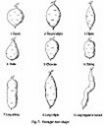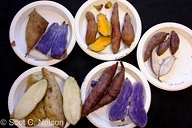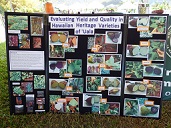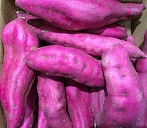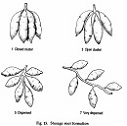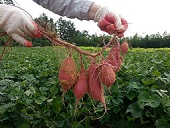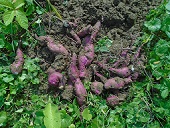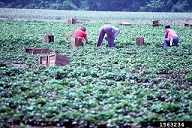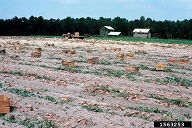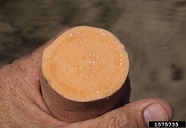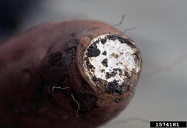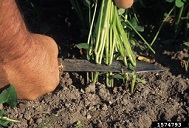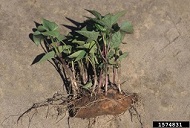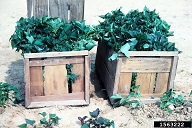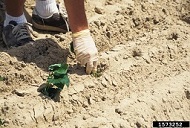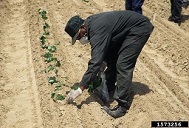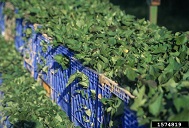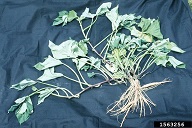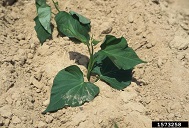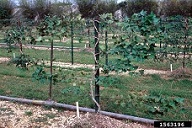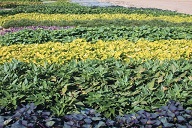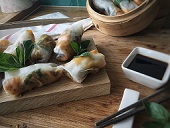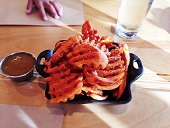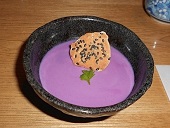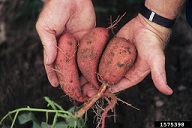| Sweetpotato, boniato, Ipomoea batatas | |||||||||||||||||||||||||||||||||||||||||||||||||||||||||||||||||||||||||||||||||||||||
|---|---|---|---|---|---|---|---|---|---|---|---|---|---|---|---|---|---|---|---|---|---|---|---|---|---|---|---|---|---|---|---|---|---|---|---|---|---|---|---|---|---|---|---|---|---|---|---|---|---|---|---|---|---|---|---|---|---|---|---|---|---|---|---|---|---|---|---|---|---|---|---|---|---|---|---|---|---|---|---|---|---|---|---|---|---|---|---|
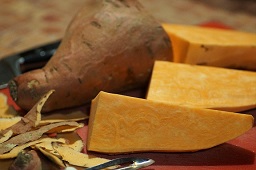 Fig. 1  Sweet potatoes batáta 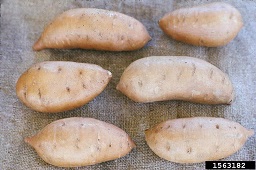 Fig. 2  Sweet potato roots after storage ready for shipment. 'Jewel' 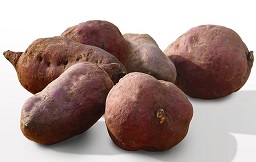 Fig. 3  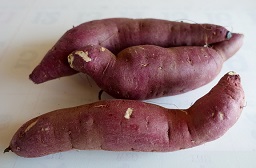 Fig. 4  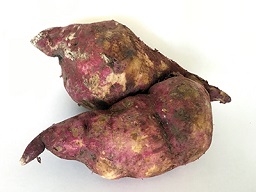 Fig. 5  Two boniato tubers with red skin (I. batatas) 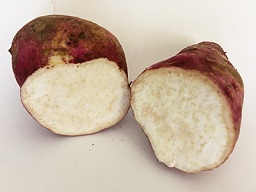 Fig. 6  A boniato tuber cut open to reveal white flesh speckled  Fig. 7  It's not hard to see where the long tapered end of sweetpotato gets the name "rat tail"  Fig. 11  Potato, sweet (I. batatas) 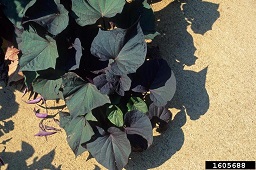 Fig. 12  Cultivar: I. batatas 'Blackie' 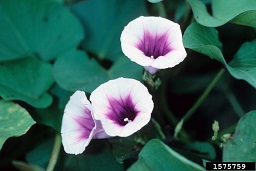 Fig. 13  Open flowers 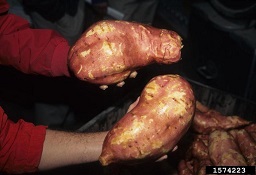 Fig. 18  Sweet potato roots can get very large. These would be graded as "jumbo." 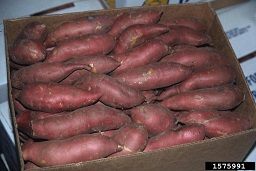 Fig. 19  High quality packed carton of red-skinned sweet potato 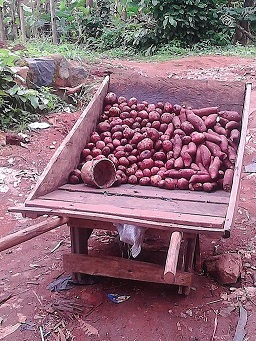 Fig. 20  A local cart carrying sweet potatoes. Uganda 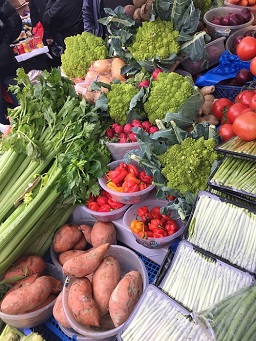 Fig. 29  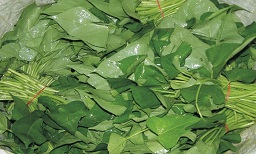 Fig. 30  Bundled leaves in the market 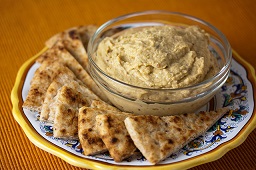 Fig. 47  Sweetpotato hummus  Fig. 48  Sweetpotato ice cream  Fig. 49  Sweet potato pecan muffins 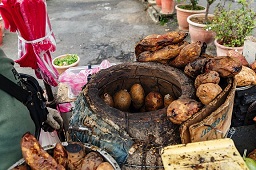 Fig. 59  Taipei, Taiwan: A hawker offering his sweetpotatoes in front of Shilin MRT Station 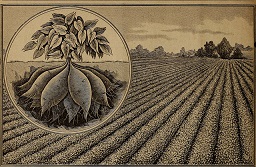 Fig. 60  Vineless Gold Coin Prolific Henry G. Gilbert Nursery and Seed Trade Catalog, 1897 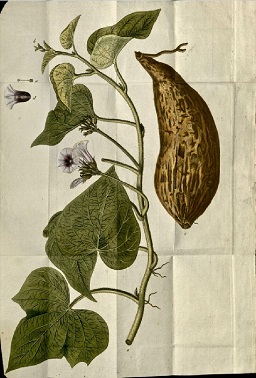 Fig. 61  Naturgeschichte der Bataten, 1796 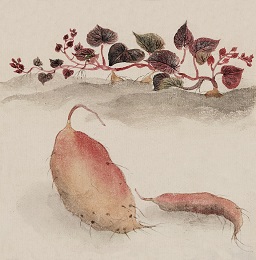 Fig. 62  Sweet potato watercolor 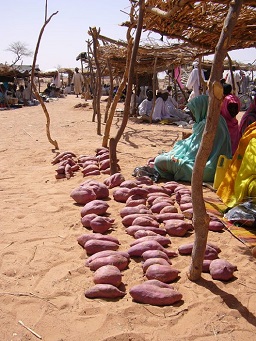 Fig. 63  Sweet potatoes at Darfur refugee camp in Chad, 2005 |
Scientific
name Ipomoea batatas (L.) Poir Pronunciation eep-oh-MEE-uh bah-TAY-tas 3 Common names English: Cuban sweet potato (USA), kuumara, sweet-potato, yam (USA), ‘uala (Hawai'i); Dutch: zoete aardappel; French: patate douce; German: Batate, Süßkartoffel; Transcribed Korean: goguma; Peru: Cuban sweet potato, kkumara, tuktuka; Portuguese: batata-doce, batata-da-terra (Brazil); Spanish: batata, boniato, camote, papa dulce (Venezuela); Swedish: batat 4 Synonyms Convolvulus batatas L., C. fastigiatus Roxb., I. fastigiata (Roxb.) Sweet. 4 Family Convolvulaceae (morning glory family) Origin Neotropics 4 USDA hardiness zones 9-11 Uses Root (tuber) starch; leaves, cooked like a green; folklore medicine; animal feed 4,11 Plant habit 3 types: trailing (vine), bunched (bush), intermediate 13 Growth rate Rapid Leaves Vary among genotypes: from heart-shaped to more or less deeply 5-lobed, or from broad and entire to deeply indented or lobed 13 Flowers Complete, corolla generally white at margins, pink to purple throats 13 Seed Capsules bear hard-coated seeds, but few seeds are produced 13 Edible root Vary in shape from long, slender to round, or pointed at one or both ends Season Warm. North: Mar-Jun; Central: Feb-June; South: Dec-Sept (orange flesh type) South Florida: year round (boniato/batatas type) Days to harvest 120-180 days 7 Soil tolerance Various types; best: loose, low clay content, well drained, relatively free of stones 13 pH preference Very tolerant 5.0-6.8 5 Soil depth Optimal: medium 20-60 in. (50-150 cm); absolute: shallow 8-20 in. (20-50 cm) 11 Spacing (inches) Plants: 10-12; row: 36 2 Plants per 10 ft2 10-12 2 Yield per 10 ft 30 lbs 2 Yield per acre Dade County: Boniato: 5-6 tons, regular sweetpotatoes: higher 1 USDA Nutrient Content: raw, boiled, baked, leaf: raw, steamed pdf Light requirement Sun Water requirement Consistent supply; inconsistent watering can cause tubers to split Soil salt tolerance Low: <4 dS/m 11 Cold tolerances Kills plant: 33.8 °F (1 °C) 11 Invasive potential * Not a problem species (un-documented) Known hazard Roots may contain the laxative ipomoein 16 Reading Material Boniato—Ipomoea batatas (L.) Poir, University of Florida pdf Sweet Potatoes, UF Gardening Solutions The word "yam" is sometimes used to describe the sweetpotato, Ipomoea batatas, a true yam comes from a different plant, Dioscorea sp. Origin Native to southern Mexico: Veracruz de Ignacio de la Llave. Neotropics. 4 Cultivated worldwide and widely naturalized in the tropics. Distribution Sweetpotato (I. batatas L.) is one of the world's most important root crops that is grown in more than 100 countries worldwide. It is an important specialty crop in the U.S. Since 1939, there has been continuous research on sweetpotato at the USDA. ... Most of the research efforts have focused on combining multiple disease and insect resistance with improved yield and food quality and understanding the genetic basis of these traits. USDA researchers have been very productive with regard to developing improved sweetpotato germplasm, with over 20 cultivars and numerous seedling selections that have been incorporated in breeding programs at Louisiana State University and North Carolina State University. 10 Description Sweetpotatoes are generally known for their colorful and nutritious roots; in addition, the young leaves and shoots are a great source of leafy greens throughout the summer, usually boiled or stir-fried. There are two types of sweetpotatoes: moist-flesh or desert type is best for baking, and dry-flesh or starch type (white to pale or purple skin) is best for boiling or frying. Further, there are three types of growth habit: trailing (vine), bunched (bush), intermediate; bush types conserve garden space. Ornamental sweetpotatoes (Fig. 10,46) and sweetpotatoes grown in the vegetable garden are different varieties of I. batatas. The ornamental varieties are grown for their attractive foliage. The roots of ornamental sweetpotatoes can be eaten. However, the ornamental varieties were selected for their attractive foliage, not their culinary qualities. The culinary qualities of the ornamental sweetpotato roots may not measure up to their vegetable counterparts. 15 In Old Hawai'i there were about 230 sweetpotato cultivars. Sweetpotato is a highly variable species, with approximately 3,000 cultivars worldwide. 13
Fig. 8. Storage root shape Fig. 9. Distribution of secondary flesh colour Fig. 10. Ornamental sweetpotato leaf types in a planter Flowers Many genotypes do not flower readily and some genotypes are sterile. 13 Varieties 'Beauregard' (Fig. 17), 'Centennial', 'Covington', 'Evangeline', 'Vardaman'. There are two varieties of Boniatos in commercial production in South Florida: 'Picadito', a dark, purple-red-skinned variety, usually grown in the fall and winter, and 'Campeon,' grown in the summer and fall. Types: moist-flesh (yams) and dry-flesh (e.g., boniata). 1,2,7
Fig. 14. Five different sweetpotato varieties grown in Hawai'i. These cooked roots display some of the variety in shape, size and color inherent in the genus. Fig. 15. Varieties on display. Uala booth at Indigenous Crop Biodiversity Festival at Maui Tropical Plantation, Waikapu, Maui, Hawai'i. Fig. 16. Purple sweetpotato. Fig. 17. Attractive sweetpotato cultivar 'Ruddy' (left) is sweet and moist and resists insects unlike the leading U.S. cultivar 'Beauregard'. Harvesting It will be nearly four months before your sweetpotatoes are ready to harvest. 6 At harvest, try to minimize skinning and bruising the roots. Undamaged potatoes will have a longer storage life. Don't allow the potatoes to be exposed to the sun for more than an hour. A good practice is to cover the potatoes with vines after placing them in crates or boxes until they can be brought in. 8 While sweetpotatoes can be grown in tropical regions year-round, plants that are left to grow for too long can encourage pest populations, and the sweetpotatoes eventually become too large and tough for most people's tastes. 6
Fig. 21. Storage root formation, arrangement of the storage roots on the underground stems Fig. 22. Root formation Fig. 23. Sweetpotato roots, cv. 'Pope' still attached to plant after digging with a plow Fig. 24. Batáta root formation Fig. 25. Harvesting Fig. 26. Filled wooden boxes at harvest Fig. 27. Baskets used for shipping sweetpotatoes to markets after storage and washing; baskets are no longer used, 1976 Fig. 28. Placement of temp/rh recorder in a pallet of sweetpotato (black box) Curing and Storage After the potatoes are dug, they should be cured to heal the cuts and bruises. Cure by storing in a warm, humid room for five to 10 days. A temperature of 80 to 90 degrees F (26.5 to 32 °C) and a relative humidity of 80% to 90% are ideal. These exact conditions will be hard to establish around the home, so select a site that comes close to these conditions. After curing, store potatoes at 55 to 60 degrees F (13 to 16 °C). Exposure to low temperatures for several days will cause the potatoes to develop a hard center and reduce their quality. When the potatoes are stored at a high temperature for a long time, they begin to sprout, shrivel and become stringy and pithy. Sweetpotatoes are not very sweet or moist when first dug. It will take six to eight weeks before they will have the sweet, moist taste and texture desired when baked. Freshly harvested potatoes don't bake well, but they can be candied or used in pies or casseroles. 8
Fig. 31. Light orange flesh color and lactation at the vascular ring Fig. 32. Sweetpotato healed cut, dark material near the perimeter of the cut surface is dried latex Propagation by vine tip cuttings Crops of sweetpotato normally grow from vine tip cuttings, about 20–30 cm (8–12 in.), from which all foliage is removed except two or three terminal leaves. Stem cuttings are planted from 15–30 cm (6–12 in.) apart at an obtuse angle of insertion, with about ⅔ of the vine covered with soil. Row spacing is about 0.9 m (3 ft). Plants grow rapidly thereafter, quickly filling in space completely with a dense canopy of sweetpotato vines of varying height. Vine height depends on sweetpotato variety, soil type and fertility, and irrigation, but generally reach 0.3–0.9 m (2–3 ft) tall. 13
Fig. 33. Sweetpotato transplant/slip cutting operation Fig. 34. Cutting sweetpotato slips above the soil line helps eliminate soilborne diseases Propagation by slips Slips (Fig. 36.) are shoots that sprout from the storage roots (Fig. 35). • How to produce your own slips. Each sweetpotato root will produce 12 to 20 slips over a three to four week period. Sweetpotato plants are often produced in open beds. The pit for the bed may be dug 6 inches deep. Place 5 or 6 inches of sand in the bottom of the pit. Place the potatoes on the sand as closely as possible without touching. The potatoes then should be covered with sand to 1 inch above the potatoes. Add an additional 2 or 3 inches of sand after the plants (slips) appear to produce a better root system. Roots of the same size should be bedded together so that the covering will be of equal depth. Sand is the best media for the production of strong, stocky slips. • When to pull plants (slips). Sweetpotato plants should be from 8 to 10 inches long when pulled. Every three years, you should replenish your "seed" roots used for slip production with new certified root stock. This will minimize the buildup of diseases and ensure plants producing roots true to type. 14 Short day length stimulates root development, whereas long day length stimulates shoot development. 13,14
Fig. 35. A bedded sweetpotato root removed from the bed to show the details of sprouting Fig. 36. A sweetpotato "slip" or transplant ready for transplanting Fig. 37. Sweet potato slips (plants) packed in bushel boxes to be taken to the field and planted Fig. 38. NC State University researchers transplant sweet potato slips for a micro propagation experiment Fig. 39. Transplanting sweet potato slips for a micro propagation experiment Commercial Planting
Fig. 40. Sweetpotato slips/transplants transported in plastic crates Fig. 41. Young plant showing enlarging roots Fig. 42. Recently transplanted sweetpotato Fig. 43,44 Transplanting/planting; two persons alternate in placing cuttings for planting in one row Fig. 45. Trellised sweetpotato plants used by plant breeder to develop improved cultivars Fig. 46. Production of different varieties Fertilizing Soils high in organic matter or highly fertile will probably need no fertilizer. Overfertilization, especially with nitrogen, causes the plants to produce an abundance of vines and few sweetpotatoes. A sidedressing of fertilizer is generally not necessary for this crop unless it is grown on extremely sandy soils. Root growth is much more sensitive to salinity than vine growth. 8,9 Irrigation Cease irrigation about one month before harvest. 13 Pests/Diseases Insect Management for Sweet Potatoes, University of Florida pdf Nematode Management in Sweet Potatoes (including Boniatos), University of Florida pdf NCPN for Sweet potato (National Clean Plant Network) ext. link Sweetpotato Weevil, Cylas formicarius (Fabricius), University of Florida pdf Tropical Vegetable Diseases: I, University of Florida pdf Weed Management in Sweet Potato, University of Florida pdf Food uses The root is eaten as vegetable: boiled, baked or fried; dried and ground into flour to make biscuits, bread, and pastries; preserved by canning, cooking and freezing, used like pumpkin as pie filling; dehydrated into chips.
Fig. 50. Sweetpotato flaky pastry, typical in Japan; Слойка с начинкой из батата, характерная для Японии Fig. 51. Mashed sweetpotatoes Fig. 52. Sweetpotato chorizo soup Fig. 53. Thai rolls, sweetpotato Fig. 54. Sweetpotato waffle fries Fig. 56. Sweetpotato milkshake at Haus Dessert Boutique, Koreatown, Los Angeles Fig. 57. Sweetpotato pumpkin sweets Fig. 58. Purple sweetpotato pudding at a restaurant in Osaka, Japan South Florida Tropicals: Boniato, University of Florida pdf (archived) Sweetpotato Recipes, 1963, USDA National Agricultural Library pdf  Fig. 64  Fig. 64. Sweet potato - universal orange (flesh only) - label Medicinal Properties ** Medicines. Various parts of the sweet potato plant and various genotypes may be used as treatments for health conditions or in medical applications such as asthma relief, laxative, induction of vomiting, and as a gargle. Parts of the plant may also be used as components of medicinal mixtures for application or ingestion. 13 Other Uses • Alcoholic beverages: sweetpotato genotypes having high sugar content in the storage roots may be cooked and then treated and fermented. • Animal feed: leaves and vines are maintenance food for hogs. The storage roots serve as food for final fattening. • Fishing: flesh of the sweetpotato storage roots of certain genotypes may be used as bait for mackerel scad fish at their offshore breeding locations. • Ceremonial: a nursing Hawaiian mother may wear a sweet potato vine garland to ensure milk flow. 13 General
Fig. 65. A great project for children. Fig. 66. Sweet potato plantlet generated from apical meristem growing in a test tube. Plants so generated are usually free of viruses. Fig. 67. Developing roots from micropropagated plant material are more uniform in size and shape. Further Reading Ipomoea batatas, Handbook of Energy Crops Ipomoea: Water, Land & See in Gardens. Glorifying Morning Glories, Eat The Weeds NCPN for Sweet potato (National Clean Plant Network) ext. link North Carolina Sweet Potato Commission Inc. ext. link Sweet Potatoes, Louisiana State University ext. link International Potato Center ext. link Older Material Sweet Potatoes and Yams, 1918, Library of Congress pdf Sweet potato culture for profit. A full account of the origin, history and botanical characteristics of the sweet potato, 1896, Library of Congress pdf Sweet potatoes: culture and uses, 1895, USDA National Agricultural Library pdf List of Growers and Vendors |
||||||||||||||||||||||||||||||||||||||||||||||||||||||||||||||||||||||||||||||||||||||
| Bibliography 1 Stephens, James M. "Boniato—Ipomoea batatas (L.) Poir." Horticultural Sciences Dept., UF/IFAS Extension, HS563, Original pub. Apr. 1994, Rev. Aug. 2015, Reviewed 2018, AskIFAS, edis.ifas.ufl.edu/mv030. Accessed 23 Mar. 2019, 28 Dec. 2023. 2 Park Brown, Sydney, et al. "Florida Vegetable Gardening Guide." Horticultural Sciences Dept., UF/IFAS Extension, SP 103, Original pub. Dec. 1999, Rev. Oct. 2015, Jan. 2016, May 2018, EDIS, edis.ifas.ufl.edu/vh021. Accessed 21 Mar. 2019. 3 Deane, Green. "Ipomoea: Water, Land & See in Gardens. Glorifying Morning Glories." Eat the Weeds and other things, too, www.eattheweeds.com/ipomoea-water-land-see-in-gardens/. Accessed 23 Mar. 2019. 4 "Taxon: Ipomoea batatas (L.) Lam. var. batatas." USDA, Agricultural Research Service, U.S. National Plant Germplasm System, GRIN-Global, npgsweb.ars-grin.gov/gringlobal/taxonomydetail.aspx?id=316363. Accessed 23 March 2019. 5 Smith, Hugh A., et al. "Vegetable Production Handbook of Florida 2018-2019." Horticultural Sciences Dept., UF/IFAS Extension, EDIS, edis.ifas.ufl.edu/pdffiles/cv/cv29200.pdf. Accessed 18 Jan. 2019. 6 "Sweet Potatoes." Gardening Solutions, UF/IFAS, gardeningsolutions.ifas.ufl.edu/plants/edibles/vegetables/sweet-potatoes.html. Accessed 26 Mar. 2019. 7 "Boniato." Gardening Solutions, UF/IFAS, gardeningsolutions.ifas.ufl.edu/plants/edibles/vegetables/boniato.html. Accessed 26 Mar. 2019. 8 Cannon, Mike. "Vegetable Gardening Hints. Growing Sweet Potatoes in the Home Garden." Vegetable Gardening Hints, Sweet Potato Research Station, Louisiana State University Agricultural Center, www.lsuagcenter.com/~/media/system/7/b/a/f/7bafc8db6de71cadbec95ddc0a871f62/pub2144sweetpotatoes.pdf. Accessed 26 Mar. 2019. 9 Shannon, M. C., and C. M. Grieve. "Tolerance of vegetable crops to salinity." Scientia Horticulturae, 78 (1999) 5-38, p. 29, USDA Agricultural Research Service, 1999, USDA/ARS, www.ars.usda.gov/arsuserfiles/20360500/pdf_pubs/P1567.pdf. Accessed 17 Mar. 2019. 10 Williams III, L. H., et al. "Current status and future direction of sweet potato research at the U. S. Vegetable Laboratory." HortScience, 51:S35-36, USDA Agricultural Research Service, 5 Feb. 2016, 26 Mar. 2019, USDA/ARS, www.ars.usda.gov/research/publications/publication/?seqNo115=324481. Accessed 27 Mar. 2019. 11 "Ipomoea batatas." Ecocrop, ecocrop.fao.org/ecocrop/srv/en/dataSheet?id=1265. Accessed 27 Mar. 2019 12 Dittmar, Peter J., et al. "Sweet potato. Chapter 15. Tropical Root Crop Production in Florida." 2018 Vegetable Production Handbook for Florida, UF/IFAS Extension, EDIS, edis.ifas.ufl.edu/vh021. Accessed 21 Mar. 2019. 13 Nelson, Scot C., and Craig Elevitch. "Cultivation." Farm and Forestry Production and Marketing Profile for Sweet potato (Ipomoea batatas), Specialty Crops for Pacific Island, Agroforestry, www.agroforestry.org/images/pdfs/Sweetpotato_specialty_crop.pdf. Accessed 28. Mar 2019. 14 Andersen, Craig R. "Sweet Potatoes." Home Gardening Series, FSA6018, University of Arkansas Division of Agriculture, Agriculture and Natural Resources, U of A Division of Agriculture Research and Extension, www.uaex.edu/publications/PDF/FSA-6018.pdf. Accessed 30 Mar. 2019. 15 "Are Ornamental Sweet Potatoes Edible?" Horticulture and Home Pests News, Iowa State University Extension and Outreach, hortnews.extension.iastate.edu/faq/are-ornamental-sweet-potatoes-edible. Accessed 30 Mar. 2019. 16 Duke, James A. "Ipomoea batatas (L.) Poir." Handbook of Energy Crops, Purdue University, Center for New Crops and Plant Products, unpublished, 1983, NewCROP™, www.hort.purdue.edu/newcrop/duke_energy/Beta_vulgaris.html. Accessed 30 Mar. 2019. Photographs Fig. 1 ivabalk. Pixabay, 15 Jan. 2019, pixabay.com/photos/sweet-potatoes-bat%C3%A1ta-exfoliate-3937451/. Accessed 31 Mar. 2019. Fig. 2 Averre, Charles. "Sweetpotato (Ipomoea batatas) (L.) Lam. Sweet potato roots after storage ready for shipment. 'Jewel'. Apr. 1976." North Carolina State University, bugwood.org, Forestry Images, no. 1563182, Bugwood, (CC BY-NC 3.0 US), www.forestryimages.org/browse/detail.cfm?imgnum=1563182. Accessed 27 Mar. 2019. Fig. 3 apassarelli. "Sweet potato." Pixabay, 20 Mar. 2019, pixabay.com/photos/sweet potato-food-healthy-organic-1975990/. Accessed 31 Mar. 2019. Fig. 4 sykoo71. "Three Sweet Potato." Pixabay, 23 Feb. 2016, pixabay.com/photos/sweet-potato-three-potato-vegetable-1248078/. Accessed 1 Apr. 2019. Fig. 5,6 "Boniato." Gardening Solutions, UF/IFAS, gardeningsolutions.ifas.ufl.edu/plants/edibles/vegetables/boniato.html. Accessed 31 Mar. 2019. Fig. 7 Holmes, Gerald. "Sweetpotato (Ipomoea batatas) (L.) Lam. It's not hard to see where the long tapered end of sweet potato gets the name 'rat tail' 1998." California Polytechnic State University at San Luis Obispo, bugwood.org, Forestry Images, no. 1574751, Uploaded 22 Oct. 2010, Updated 1 June 2013, Bugwood, (CC BY-NC 3.0 US), www.forestryimages.org/browse/detail.cfm?imgnum=1574751. Accessed 27 Mar. 2019. Fig. 8 CIP, AVRDC, IBPGR. "Storage root shape. 1991." Descriptors for Sweet Potato, International Board for Plant Genetic Resources, Biodiversity International, (CC BY-NC-ND 4.0), www.bioversityinternational.org/index.php?id=244&tx_news_pi1%5Bnews%5D=273&cHash=130628b94dd86a553c0ba18c61469ae5. Accessed 28 Mar. 2019. Fig. 9 CIP, AVRDC, IBPGR. "Distribution of secondary flesh colour. 1991." Descriptors for Sweet Potato, International Board for Plant Genetic Resources, Biodiversity International, (CC BY-NC-ND 4.0), www.bioversityinternational.org/index.php?id=244&tx_news_pi1%5Bnews%5D=273&cHash=130628b94dd86a553c0ba18c61469ae5. Accessed 28 Mar. 2019. Fig. 10 Holmes, Gerald. "Sweetpotato (Ipomoea batatas) (L.) Lam. Ornamental sweet potato leaf types in a planter. 2 Aug. 1999." California Polytechnic State University at San Luis Obispo, bugwood.org, Forestry Images, no. 156348, Uploaded 8 Nov. 2010, Updated 25 Oct. 2013, Bugwood, (CC BY-NC 3.0 US), www.forestryimages.org/browse/detail.cfm?imgnum=1576348. Accessed 27 Mar. 2019. Fig. 11 "Potato, Sweet (Ipomoea batatas)." Plant Florida Identification, Gardening Solutions, UF/IFAS, 15 July 2009, www.gardeningsolutions.ifas.ufl.edu/mastergardener/outreach/plant_id/vegetables/potato_sw.shtml. Accessed 26 Mar. 2019. Fig. 12 Ruter, John. "Sweetpotato (Ipomoea batatas) (L.) Lam. 'Blackie'." University of Georgia, bugwood.org, Forestry Images, no. 1605688, Uploaded 1 Mar. 2012, Updated 22 Feb. 2018, Bugwood, (CC BY-NC 3.0 US), www.forestryimages.org/browse/detail.cfm?imgnum=1605688. Accessed 27 Mar. 2019. Fig. 13 Holmes, Gerald. "Sweetpotato (Ipomoea batatas) (L.) Lam. Open flowers. Oct. 1998." California Polytechnic State University at San Luis Obispo, bugwood.org, Forestry Images, no. 1575759, Uploaded 1 Mar. 2012, Updated 22 Feb. 2018, Bugwood, (CC BY-NC 3.0 US), www.forestryimages.org/browse/detail.cfm?imgnum=1575759. Accessed 27 Mar. 2019. Fig. 14 Elevitch, Craig. "Five different sweet potato varieties grown in Hawai'i." Farm and Forestry Production and Marketing Profile for Sweet potato (Ipomoea batatas), Specialty Crops for Pacific Island, Agroforestry, www.agroforestry.org/images/pdfs/Sweetpotato_specialty_crop.pdf. Accessed 28. Mar 2019. Fig. 15 Forest, and Kim Starr. "Ipomoea batatas (Sweet potato). Varieties on display. Uala booth at Indigenous Crop Biodiversity Festival at Maui Tropical Plantation Waikapu, Maui, Hawai'i." Flickr, 27 Aug. 2016, (CC BY 2.0), www.flickr.com/photos/starr-environmental/29668499285/ Accessed 28. Mar 2019. Fig. 16 auntmasako. "Sweet Potato Purple." Pixabay, 12 Aug. 2016, pixabay.com/photos/sweet-potato-purple-seiyu-ltd-1586319/. Accessed 1 Apr. 2019. Fig. 17 Bauer, Scott. "Sweetpotato (Ipomoea batatas) (L.) Lam. New attractive sweet potato cultivar 'Ruddy' (left) is sweet and moist and resists insects unlike the leading U.S. cultivar 'Beauregard'. 5 Mar. 2003." USDA Agricultural Research Service, bugwood.org, Forestry Images, no. 1319044, Uploaded 5 Mar. 2003, Updated 8 July 2011, Bugwood, (CC BY-NC 3.0 US). www.forestryimages.org/browse/detail.cfm?imgnum=1319044. Accessed 27 Mar. 2019. Fig. 18 Holmes, Gerald. "Sweetpotato (Ipomoea batatas) (L.) Lam. Sweet potato roots can get very large. These would be graded as "jumbo"." California Polytechnic State University at San Luis Obispo, bugwood.org, Forestry Images, no. 1574223, Uploaded 21 Oct. 2010, Updated 24 Apr. 2013, Bugwood, (CC BY-NC 3.0 US), www.forestryimages.org/browse/detail.cfm?imgnum=1574223. Accessed 27 Mar. 2019. Fig. 19 Holmes, Gerald. "Sweetpotato (Ipomoea batatas) (L.) Lam. High quality packed carton of red-skinned sweet potato. Dec. 1998." California Polytechnic State University at San Luis Obispo, bugwood.org, Forestry Images, no. 1575991, Uploaded 29 Oct. 2010, Updated 3 Oct. 2013, Bugwood, (CC BY-NC 3.0 US), www.forestryimages.org/browse/detail.cfm?imgnum=1575991. Accessed 27 Mar. 2019. Fig. 20 Bukulu Steven. "A local cart carrying sweet potatoes, Uganda." Wikimedia Commons, 4 Oct. 2014, (CC BY-SA 4.0), commons.wikimedia.org/wiki/File:Sweet_Potatoes.jpg. Accessed 28. Mar 2019. Fig. 21 CIP, AVRDC, IBPGR. "Storage root formation, Arrangement of the storage roots on the underground stems." Descriptors for Sweet Potato, 1991, International Board for Plant Genetic Resources, Biodiversity International, (CC BY-NC-ND 4.0), www.bioversityinternational.org/index.php?id=244&tx_news_pi1%5Bnews%5D=273&cHash=130628b94dd86a553c0ba18c61469ae5. Accessed 28 Mar. 2019. Fig. 22 saint1533. Pixabay, 5 Oct. 2013, pixabay.com/photos/sweet-potato-garden-plot-thu-harvest-1241696/. Accessed 1 Apr. 2019. Fig. 23 Averre, Charles. "Sweetpotato (Ipomoea batatas) (L.) Lam. Sweet potato roots, cv. 'Pope' still attached to plant after digging with a plow. Oct. 1977." North Carolina State University, bugwood.org, Forestry Images, no. 1563271, Uploaded 22 Jan. 2009, Updated 8 July 2011, Bugwood, (CC BY-NC 3.0 US), www.forestryimages.org/browse/detail.cfm?imgnum=1563271. Accessed 27 Mar. 2019. Fig. 24 Cseperke. Pixabay, 24 Sep. 2017, pixabay.com/photos/bat%C3%A1ta-sweet-potato-2782146//. Accessed 1 Apr. 2019. Fig. 25 Averre, Charles. "Sweetpotato (Ipomoea batatas) (L.) Lam. Harvesting." North Carolina State University, bugwood.org, Forestry Images, no. 1563234, Uploaded 22 Jan. 2009, Updated 17 July 2018, Bugwood, (CC BY-NC 3.0 US), www.forestryimages.org/browse/detail.cfm?imgnum=1563234. Accessed 27 Mar. 2019. Fig. 26 Averre, Charles. "Sweetpotato (Ipomoea batatas) (L.) Lam. Filled wooden boxes at harvest. c. 1970" North Carolina State University, bugwood.org, Forestry Images, no. 1563253, Uploaded 22 Jan. 2009, Updated 17 July 2018, Bugwood, (CC BY-NC 3.0 US), www.forestryimages.org/browse/detail.cfm?imgnum=1563253. Accessed 27 Mar. 2019. Fig. 27 Averre, Charles. "Sweetpotato (Ipomoea batatas) (L.) Lam. Baskets used for shipping sweet potatoes to markets after storage and washing. Baskets are no longer used. Apr. 1976." North Carolina State University, bugwood.org, Forestry Images, no. 1563189, Uploaded 22 Jan. 2009, Updated 12 Aug. 2009, Bugwood, (CC BY-NC 3.0 US), www.forestryimages.org/browse/detail.cfm?imgnum=1563189. Accessed 27 Mar. 2019. Fig. 28 Holmes, Gerald. "Sweetpotato (Ipomoea batatas) (L.) Lam. Placement of temp/rh recorder in a pallet of sweetpotato (black box). Mar. 1998." California Polytechnic State University at San Luis Obispo, bugwood.org, Forestry Images, no. 1574661, Uploaded 22 Oct. 2010, Updated 26 May 2013, Bugwood, (CC BY-NC 3.0 US), www.forestryimages.org/browse/detail.cfm?imgnum=1574661. Accessed 27 Mar. 2019. Fig. 29 dodmichaela. Pixabay, 24 Oct. 2015, pixabay.com/photos/vegetables-produce-sweet-potatoes-1016297/. Accessed 1 Apr. 2019. Fig. 30 Lin LJ, et al. "Sweet potato. Bundled leaves in the market. July 4, 2012." Discovering Indigenous Treasures: Promising Indigenous Vegetables From Around The World, no. 09-720, AVRDC, World Vegetable Center, (CC BY-NC-SA 3.0), avrdc.org/wpfb-file/ebook1-htm/. Accessed 5 Apr. 2019. Fig. 31 Holmes, Gerald. "Sweetpotato (Ipomoea batatas) (L.) Lam. Light orange flesh color and lactation at the vacular ring. Oct. 1998." California Polytechnic State University at San Luis Obispo, bugwood.org, Forestry Images, no. 1575735, Uploaded 29 Oct. 2010, Updated 30 Sept. 2013, Bugwood, (CC BY-NC 3.0 US), www.forestryimages.org/browse/detail.cfm?imgnum=1575735. Accessed 27 Mar. 2019. Fig. 32 Holmes, Gerald. "Sweetpotato (Ipomoea batatas) (L.) Lam. Sweet potato healed cut. Dark material near the parimeter of the cut surface is dried latex. Nov. 1997." California Polytechnic State University at San Luis Obispo, bugwood.org, Forestry Images, no. 1574181, Uploaded 21 Oct. 2010, Updated 23 Apr. 2013, Bugwood, (CC BY-NC 3.0 US), www.forestryimages.org/browse/detail.cfm?imgnum=1574181. Accessed 27 Mar. 2019. Fig. 33 Holmes, Gerald. "Sweetpotato (Ipomoea batatas) (L.) Lam. Sweet potato transplant/slip cutting operation. May 1998." California Polytechnic State University at San Luis Obispo, bugwood.org, Forestry Images, no. 1574794, Uploaded 22 Oct. 2010, Updated 4 June 2013, Bugwood, (CC BY-NC 3.0 US), www.forestryimages.org/browse/detail.cfm?imgnum=1574794. Accessed 27 Mar. 2019. Fig. 34 Holmes, Gerald. "Sweetpotato (Ipomoea batatas) (L.) Lam. Cutting sweet potato slips above the soil line helps eliminate soilborne diseases such as scurf. May 1998." California Polytechnic State University at San Luis Obispo, bugwood.org, Forestry Images, no. 1574794, Uploaded 22 Oct. 2010, Updated 4 June 2013, Bugwood, (CC BY-NC 3.0 US), www.forestryimages.org/browse/detail.cfm?imgnum=1574793. Accessed 27 Mar. 2019. Fig. 35 Holmes, Gerald. "Sweetpotato (Ipomoea batatas) (L.) Lam. A bedded sweet potato root removed from the bed to show the details of sprouting. May 1998." California Polytechnic State University at San Luis Obispo, bugwood.org, Forestry Images, no. 1574831, Uploaded 22 Oct. 2010, Updated 4 June 2013, Bugwood, (CC BY-NC 3.0 US), www.forestryimages.org/browse/detail.cfm?imgnum=1574831. Accessed 27 Mar. 2019. Fig. 36 Holmes, Gerald. "Sweetpotato (Ipomoea batatas) (L.) Lam. A sweet potato "slip" or transplant ready for transplanting. May 1997." California Polytechnic State University at San Luis Obispo, bugwood.org, Forestry Images, no. 1572946, Uploaded 19 Aug. 2009, Updated 15 Jan. 2013, Bugwood, (CC BY-NC 3.0 US), www.forestryimages.org/browse/detail.cfm?imgnum=1572946. Accessed 27 Mar. 2019. Fig. 37 Averre, Charles. "Sweetpotato (Ipomoea batatas) (L.) Lam. Sweet potato slips (plants) packed in bushel boxes to be taken to the field and planted. June 1978" North Carolina State University, bugwood.org, Forestry Images, no. 1563222, Uploaded 22 Jan. 2009, Updated 14 Apr. 2012, Bugwood, (CC BY-NC 3.0 US), www.forestryimages.org/browse/detail.cfm?imgnum=1563222. Accessed 27 Mar. 2019. Fig. 38 Holmes, Gerald. "Sweetpotato (Ipomoea batatas) (L.) Lam. NC State University researchers transplant sweet potato slips for a micro propagation experiment. c. June 1977." California Polytechnic State University at San Luis Obispo, bugwood.org, Forestry Images, no. 1573252, Uploaded 15 Oct. 2010, Updated 12 Dec. 2012, Bugwood, (CC BY-NC 3.0 US), www.forestryimages.org/browse/detail.cfm?imgnum=1573252. Accessed 27 Mar. 2019. Fig. 39 Holmes, Gerald. "Sweetpotato (Ipomoea batatas) (L.) Lam. Planting sweet potato slips. June 1997." California Polytechnic State University, bugwood.org, Forestry Images, no. 1573256, Uploaded 15 Oct. 2010, Updated 20 Dec. 2012, Bugwood, (CC BY-NC 3.0 US), www.forestryimages.org/browse/detail.cfm?imgnum=1573256. Accessed 27 Mar. 2019. Fig. 40 Holmes, Gerald. "Sweetpotato slips/transplants transported in plastic crates. May 1998." California Polytechnic State University at San Luis Obispo, bugwood.org, Forestry Images, no. 1574819, Bugwood, (CC BY-NC 3.0 US), www.forestryimages.org/browse/detail.cfm?imgnum=1574819. Accessed 10 Apr. 2019. Fig. 41 Averre, Charles. "Sweetpotato (Ipomoea batatas) (L.) Lam. Young plant showing enlarging roots." North Carolina State University at San Luis Obispo, bugwood.org, Forestry Images, no. 1563256, Uploaded 22 Jan. 2009, Updated 17 July 2018, Bugwood, (CC BY-NC 3.0 US), www.forestryimages.org/browse/detail.cfm?imgnum=1563256. Accessed 27 Mar. 2019. Fig. 42 Holmes, Gerald. "Sweetpotato (Ipomoea batatas) (L.) Lam. Recently transplanted sweet potato. June 1997." California Polytechnic State University at San Luis Obispo, bugwood.org, Forestry Images, no. 1573258, Uploaded 15 Oct. 2010, Updated 20 Dec. 2012, Bugwood, (CC BY-NC 3.0 US), www.forestryimages.org/browse/detail.cfm?imgnum=1573258. Accessed 27 Mar. 2019. Fig. 43 Averre, Charles. "Sweetpotato (Ipomoea batatas) (L.) Lam. Transplanting. Two persons alternate in placing cuttings for planting in one row, County Agent P. Westerbeek third from left. June 1990." North Carolina State University, bugwood.org, Forestry Images, no. 1563246, Uploaded 22 Jan. 2009, Updated 21 Aug. 2009, Bugwood, (CC BY-NC 3.0 US), www.forestryimages.org/browse/detail.cfm?imgnum=1563246. Accessed 27 Mar. 2019. Fig. 44 Holmes, Gerald. "Sweetpotato (Ipomoea batatas) (L.) Lam. Planting sweet potato slips. May 1998." California Polytechnic State University at San Luis Obispo, bugwood.org, Forestry Images, no. 1573256, Uploaded 20 Oct. 2010, Updated 4 June 2013, Bugwood, (CC BY-NC 3.0 US), www.forestryimages.org/browse/detail.cfm?imgnum=1574785. Accessed 27 Mar. 2019. Fig. 45 Averre, Charles. "Sweetpotato (Ipomoea batatas) (L.) Lam. Trellised sweet potato plants used by plant breeder to develop improved cultivars. 1974." North Carolina State University, bugwood.org, Forestry Images, no. 1563196, Uploaded 22 Jan. 2009, Updated 12 Aug. 2009, Bugwood, (CC BY-NC 3.0 US), www.forestryimages.org/browse/detail.cfm?imgnum=1563196. Accessed 27 Mar. 2019. Fig. 46 Lin LJ, et al. "Sweet potato, Production of different varieties." Discovering Indigenous Treasures: Promising Indigenous Vegetables From Around The World, no. 09-720, AVRDC, July 4, 2012, World Vegetable Center, (CC BY-NC-SA 3.0), avrdc.org/wpfb-file/ebook1-htm/. Accessed 5 Apr. 2019. Fig. 47 Veganbaking.net. "Sweet Potato Hummus." Flickr, 9 Jan. 2011, (CC BY-SA 2.0), www.flickr.com/photos/31104779@N02/5384913459. Accessed 28. Mar 2019. Fig. 48 Veganbaking.net. "Vegan Sweet Potato Ice Cream." Flickr, 31 Aug. 2009, (CC BY-SA 2.0), www.flickr.com/photos/vegan-baking/4107600688/. Accessed 28. Mar 2019. Fig. 49 Natalie HG. "Sweet potato pecan." Flickr, 21 Oct. 2009, (CC BY 2.0), www.flickr.com/photos/nataliehg/4110403890/in/photostream/. Accessed 28. Mar 2019. Fig. 50 Laitr Keiows. "Sweet potato flaky pastry, typical in Japan, Слойка с начинкой из батата, характерная для Японии." Wikimedia Commons, 15 Nov. 2009, (CC BY-SA 3.0), commons.wikimedia.org/wiki/File:Sweet_potato_flaky_pastry.jpg. Accessed 28. Mar 2019. Fig. 51 Rodrigo.Argenton. "Mashed Sweet Potatoes." Wikimedia Commons, 22 Nov. 2010, (CC BY 2.0), commons.wikimedia.org/wiki/File:Mashed_Sweet_Potatoes_(140491569).jpeg. Accessed 28. Mar 2019. Fig. 52 jeffreyw. "Sweet potato chorizo soup." Flickr, 6 Oct. 2010, (CC BY 2.0), www.flickr.com/photos/jeffreyww/5058084454/. Accessed 28. Mar 2019. Fig. 53 Buntysmum. Pixabay, 31 May 2015, pixabay.com/photos/thai-rolls-sweet-potato-vegetables-1074595/. Accessed 1 Apr. 2019. Fig. 54 T.Tseng. "Sweet potato waffle fries." Flickr, 27 Aug. 2013, (CC BY 2.0), www.flickr.com/photos/68147320@N02/9696449675. Accessed 28. Mar 2019. Fig. 55 Wurzinger, Bernadette. Pixabay, 23 Jan. 2017, pixabay.com/photos/yam-potato-sweet-potato-eat-2006312/. Accessed 31 Mar. 2019. Fig. 56 Veganbaking.net. "Sweet potato milkshake at Haus Dessert Boutique, Koreatown, L.A." Flickr, 31 Aug. 2009. (CC BY 2.0), www.flickr.com/photos/vegan-baking/4107600688/ Accessed 28. Mar 2019. Fig. 57 Janine. "Sweet potato pumpkin sweets." Flickr, 13 Jan. 2008, (CC BY 2.0), www.flickr.com/photos/geishabot/2196133929/in/photostream/. Accessed 28. Mar 2019. Fig. 58 Ailemadrah. "Purple sweet potato pudding at a restaurant in Osaka, Japan." Wikimedia Commons, 5 July 2013, (CC BY-SA 3.0), commons.wikimedia.org/wiki/File:Purple_sweet_potato_pudding_in_Osaka.jpg. Accessed 28. Mar 2019. Fig. 59 CEphoto, Uwe Aranas. "Taipei, Taiwan: A hawker offering his Sweet Potatoes in front of Shilin MRT Station." Wikimedia Commons, 23 Dec. 2015, (CC BY-SA 4.0), commons.wikimedia.org/wiki/File:Taipei_Taiwan_Sweet-Potato-Hawker-with-his-mobile-stall-02.jpg. Accessed 28. Mar 2019. Fig. 60 "Sweet Potato, Vineless Gold Coin Prolific, General list: tested seeds for 1897." Huntington and Page, Henry G. Gilbert Nursery and Seed Trade Catalog Collection, P. 5, Flickr, www.flickr.com/photos/internetarchivebookimages/20548594375/. Accessed 28. Mar 2019. Fig. 61 Franz Joseph Märter. "Naturgeschichte der Bataten." Wikimedia Commons, 31 Dec. 1796, Public Domain, commons.wikimedia.org/w/index.php?curid=74692707. Accessed 28. Mar 2019. Fig. 62 Prawny. Pixabay, pixabay.com/illustrations/watercolour-watercolor-art-painting-1831852/. Accessed 1 Apr. 2019. Fig. 63 Mark Knobil. "Sweet potatoes at Darfur refugee camp in Chad." Flickr, 29 Mar. 2005, (CC BY 2.0), www.flickr.com/photos/36448457@N00/66824865. Accessed 28. Mar 2019. Fig. 64 Smith, Tara. "Sweet Potato - Universal Orange (flesh only) - Label - Vertical, Universal Orange Labels." Louisiana State University Agricultural Center, 31 Aug. 2018, www.lsuagcenter.com/profiles/lblack/articles/page1535735890550. Accessed 26 Mar. 2019. Fig. 65 elletakesphotos. Pixabay, 25 Mar. 2017, pixabay.com/photos/nature-sweet-potato-grow-vegetable-3364949/. Accessed 1 Apr. 2019. Fig. 66 Averre, Charles. "Sweet potato plantlet generated from apical mesistem growing in a test tube. Plants so generated are usually free of viruses. 22 Jan. 2009." North Carolina State University, bugwood.org, Forestry Images, no. 1563211, Uploaded 22 Jan. 2009, Updated 12 Aug. 2009, Bugwood, (CC BY-NC 3.0 US), www.forestryimages.org/browse/detail.cfm?imgnum=1563211. Accessed 27 Mar. 2019. Fig. 67 Holmes, Gerald. "Sweetpotato (Ipomoea batatas) (L.) Lam. Developing roots from micropropagated plant material are more uniform in size and shape. Aug. 1998." California Polytechnic State University at San Luis Obispo, bugwood.org, Forestry Images, no. 1575398, Uploaded 26 Oct. 2010, Updated 15 June 2013, Bugwood, (CC BY-NC 3.0 US), www.forestryimages.org/browse/detail.cfm?imgnum=1575398. Accessed 27 Mar. 2019. * UF/IFAS Assessment of Non-native Plants in Florida's Natural Areas ** The information provided above is not intended to be used as a guide for treatment of medical conditions using plants. Published 10 Apr. 2019 KJ. Last update 28 Dec. 2023 LR |
|||||||||||||||||||||||||||||||||||||||||||||||||||||||||||||||||||||||||||||||||||||||
